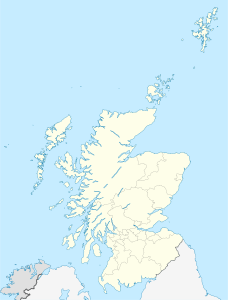Bone Caves
| Bone Caves
|
||
|---|---|---|
|
Bone Caves |
||
| Location: | Highlands | |
|
Geographic location: |
58 ° 6 '29.5 " N , 4 ° 56' 25.8" W | |
|
|
||
| Geology: | limestone | |
The Bone Caves are several caves in the Northwest Highlands in Scotland . They are located in the sparsely populated region of Assynt , about five kilometers south of the small town of Inchnadamph and about 35 kilometers north of Ullapool . They got their name after geological investigations at the end of the 19th century discovered the bones of Ice Age animals.
location
The Bone Caves are located in the valley of the Allt nan Uamh , a small stream that rises southeast of the Ben More Assynt , and about two kilometers west of the caves, shortly after it passes under the A837 , flows into the River Loanan , a tributary of Loch Assynt . The Gaelic name of the stream can be translated as the stream of the caves . You are on the orographic left side of the valley a little above the valley floor in the limestone cliffs of the Creag nan Uamh , which tower about a hundred meters above the valley. In total there are four larger and various smaller caves in the walls. The four large caves are named Fox's Den (Gaelic Saobhaidh Sionnaich ), Bone Cave ( Uamh nan Cnàmhan ), Reindeer Cave ( Uamh nan Rèin-fhiadh ) and Badger Cave ( Uamh nam Broc ) according to the bones found from east to west . The caves are connected by passages and form one of the largest cave systems in Scotland, with narrow passages and crevices extending up to a kilometer into the mountain. Without special equipment, only the first few meters are accessible.
Emergence
The caves formed more than 150,000 years in the thrust of the Moine Thrust . The softer limestone was dissolved here between two layers by erosion over the millennia, whereupon the cave system gradually developed. This was originally just above the valley floor, which was only lowered to today's level during the subsequent ice ages .
Finds
The caves were first examined in 1889 by the two geologists Benjamin Neeve Peach and John Horne , who discovered various animal bones in the entrance area of the caves. The first extensive excavations took place in 1926. In addition to reindeer antlers and a bear's teeth, bones of frogs , snakes and wild cats have been discovered. In the following year the excavations continued and further bones and antler remains were discovered. In the course of the following years there were further excavations. A large number of reindeer bones between the ages of 47,000 and 8300 years, the skull of a Eurasian lynx - the only find of its kind in Scotland to date - and bones of lemmings , arctic foxes , wolves and brown bears were discovered . The assignment of individual bear bones to a polar bear is not entirely certain .
Human remains were also found in the Reindeer Cave , including a skull that had apparently been buried. This and other bones came from a total of four people who had probably been buried there. Using the radiocarbon method , the human bones could be dated to an age of 4515 to 4720 years. However, the caves were probably not used permanently as dwelling places; it is assumed that they will be used temporarily, for example for hunting. More recent animal finds are around 4,500 years old, the bones of red deer , roe deer , rabbits , badgers , pine martens as well as grouse and black grouse suggest that the highlands in this area were forested earlier. Not all animal bones can be traced back to the use of the caves by animals, some of them have also been brought into the caves through erosion processes.


